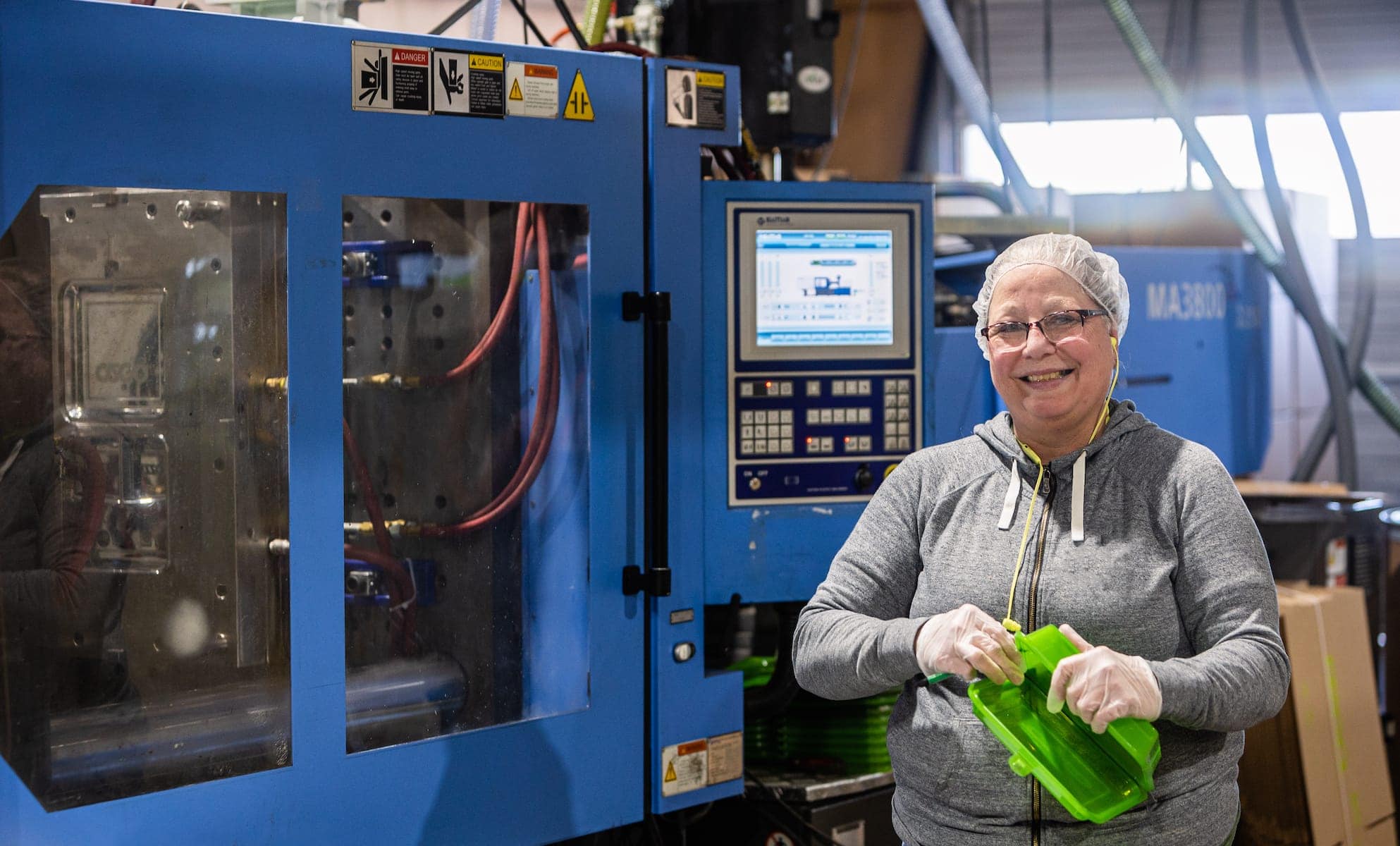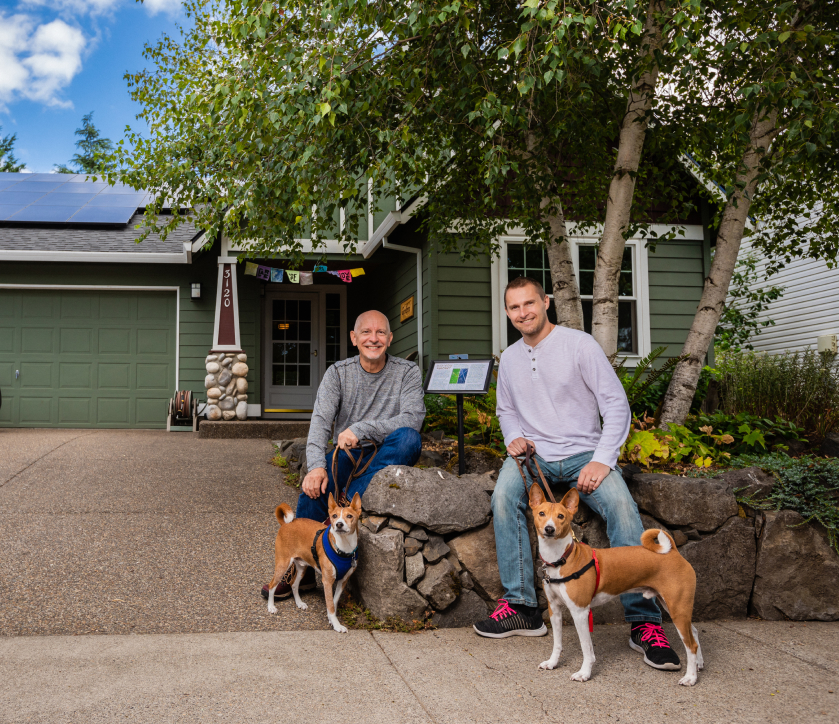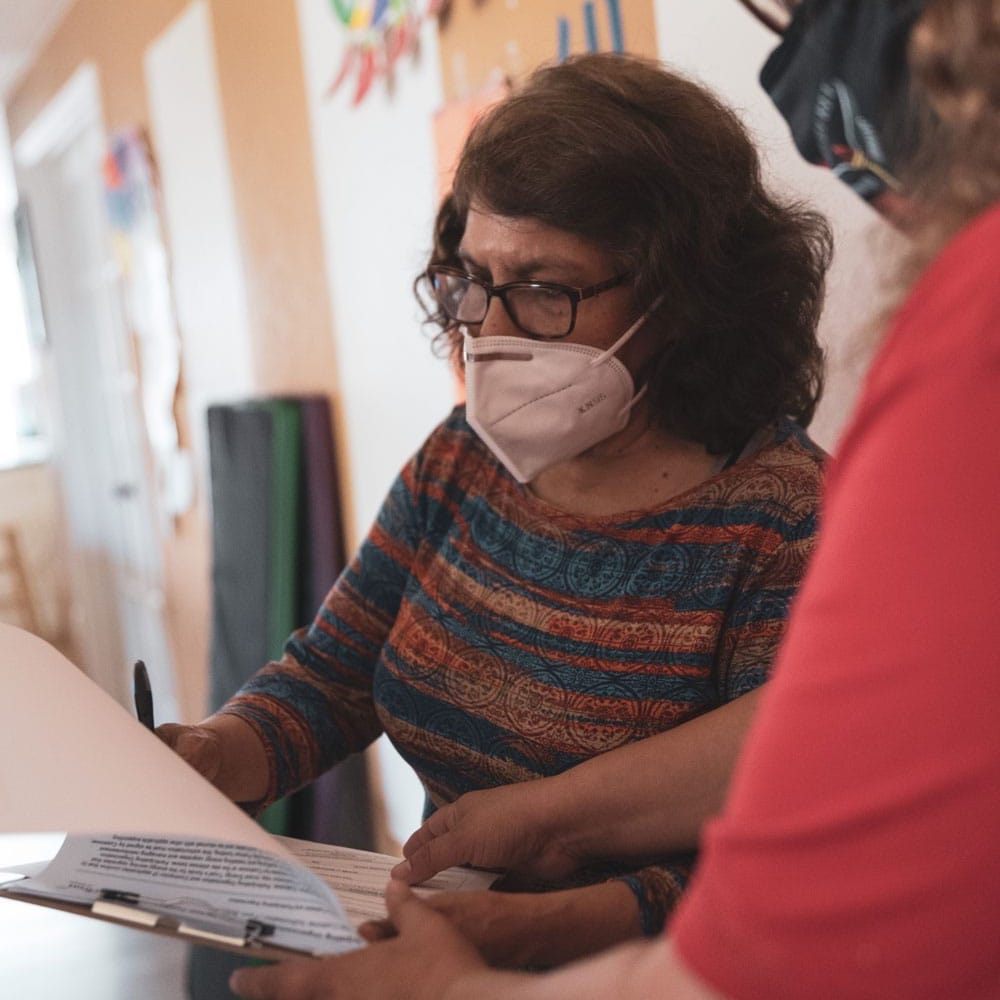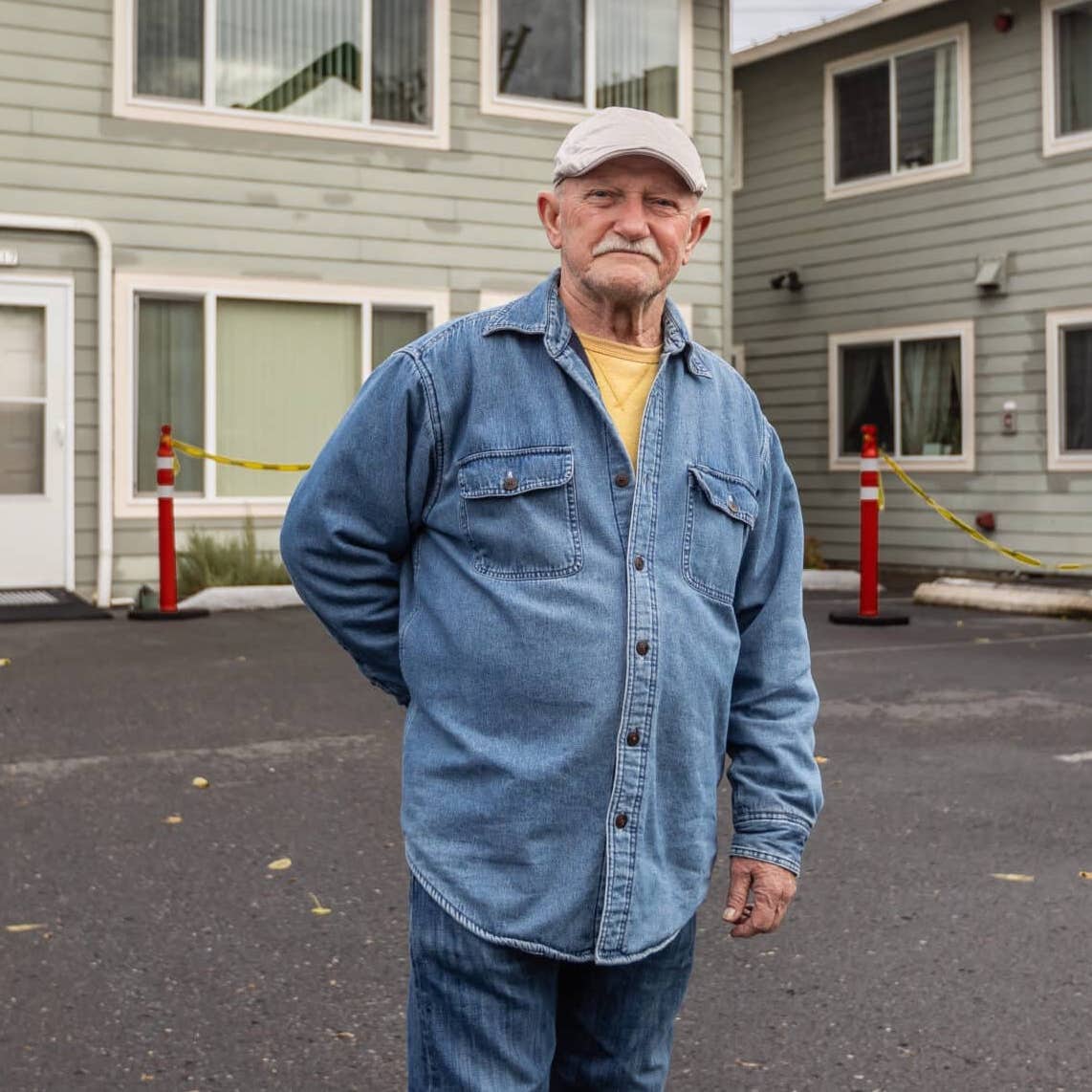Explore The 2021 Annual Report

2021 Annual Report
Clean, affordable energy for Oregon
Year in Review
Michael Colgrove, Executive Director
Thanks to our range of energy efficiency and renewable energy programs developed over 20 years, Energy Trust was able to help customers and communities reap the benefits of clean power despite continued instability caused by the COVID-19 pandemic in 2021.
If the theme for 2020 was grappling with the pandemic’s unprecedented disruptions to our daily lives, 2021 was about getting back to business - and navigating vaccine availability, multiple Coronavirus variants and the resulting equipment and labor shortages, market volatility and high demand for certain home upgrades. Energy Trust was able to adapt to these challenges by adjusting incentive offers and outreach in real time and managing programs across our portfolio.
As the pandemic's effects dragged on, the summer of 2021 brought a stark reminder of other pressures on our energy system and people’s lives in the form of a record-setting heat wave for the Northwest. Coupled with wildfires, heat events like these are driving up demand for technologies that help people manage and prepare for extreme weather, like air conditioners and HVAC systems that keep spaces cool and ventilated and solar systems with battery storage that can help keep the lights on during disaster events. As we’re seeing with wildfire rebuilding efforts in Southern Oregon, these upgrades can give communities reason to hope.
Providing energy upgrades can have life-saving impacts. This was something we heard repeatedly from communities and partners, along with the need for affordable housing, investment in infrastructure, and ways to help mitigate the effects of climate change and be resilient in the face of natural disasters. Energy efficiency and renewable energy have a place in all of these conversations. They help keep housing costs low, lower the cost to operate municipal facilities, reduce greenhouse gas emissions and — when solar systems are paired with batteries — keep the power on when disaster strikes.
At the state level, 2021 saw the passage of a slew of legislation aimed at promoting clean energy and energy equity. While this is an exciting step forward for Oregon, we also know real change happens on the ground and in partnership with trusted community groups, like EUVALCREE in Eastern Oregon, which is helping connect Spanish-speaking residents with energy-saving opportunities. And supporting workforce diversity — something the energy industry is sorely lacking — requires collaboration with experienced business leaders like David Burchfield of Burch Energy Services. You’ll find both of their stories in this report, along with examples of how Energy Trust is supporting communities as they rebuild after wildfires and helping businesses like Meduri Farms manage energy costs.
People and communities reaped these benefits thanks to the energy they saved and generated with Energy Trust’s incentives and support. In 2021 alone, we helped Oregon and southwest Washington customers save 44 average megawatts of electricity, save 7.4 million annual therms of natural gas and generate 5.43 aMW of clean power. Those investments add up to $451 million in utility bill savings and 162,000 metric tons of carbon dioxide avoided.
Thank you to all who helped us achieve our 2021 results, including our customers, Portland General Electric, Pacific Power, NW Natural, Cascade Natural Gas, Avista, the Oregon Public Utility Commission, Northwest Energy Efficiency Alliance, Oregon Department of Energy, Oregon Housing and Community Services, trade ally contractors, cities, counties and community organizations.

20 Years of Clean Energy
Clean energy investments since 2002 bring lasting benefits, creating a more sustainable energy future

aMW
electricity saved and generated
Million therms
natural gas saved
Million
tons of carbon dioxide avoided
average Oregon homes powered by all the energy saved and generated
Solar systems
installed on homes and businesses
Billion
added to Oregon’s economy
Billion
saved by participants on utility bills
Professionals
employed by trade ally contractors
Cleaner air
lower greenhouse gas emissions help reach climate goals
Livable homes
efficient homes are more comfortable, affordable and safer during extreme temperatures
Resilient communities
efficient buildings with solar and batteries better withstand disaster events
Improved infrastructure
modern, efficient public buildings and irrigation systems work better and cost less to operate
Diversity, Equity and Inclusion Goals
In 2021, we built on progress and lessons from two years of diversity, equity and inclusion goals to better serve communities of color, customers with low incomes and rural communities
| GOAL | ACTIVITY HIGHLIGHTS | LESSONS LEARNED | STATUS |
|---|---|---|---|
| Increase participation of people of color in residential offers | Distributed $250,000 more in incentives through Community Partner Funding pathway compared with 2020 Provided $271,891 in co-funding to Community Action of Washington County | Energy Trust should refine community-focused offers Energy Trust should collect demographic data | Green dot Achieved |
| Support participation of small and medium commercial businesses in rural areas | Served 1,270 small and medium businesses including 39 in very rural areas Provided more than 200 businesses with no-cost energy assessments | Small businesses should be defined based on number of employees and square footage, not energy use Relationships are key and building trust takes time | Yellow dot Partially achieved |
| Increase participation of small and medium industrial businesses in rural areas | Collaborated with local trade organizations to reach new customers Launched a no-cost direct lighting installation offer | In-person visits motivate participation Energy Trust should implement new mechanisms to collect data | Green dot Achieved |
| Increase solar projects benefiting customers of color, those with low incomes and rural customers | Engaged 424 households in Solar Within Reach, over 300 more than in 2020 | Solar Within Reach should be a priority offer | Yellow dot Partially achieved |
| Increase participation in the Trade Ally Network by BIPOC-owned and women-owned businesses | Designed a Contractor Development Pathway Launched a Pathway to Certification | Energy Trust should connect with local contractors through community-based organizations Administrative requirements can pose a burden to very small contractor businesses | Yellow dot Partially achieved |
| Increase the number of projects completed by BIPOC-owned and women-owned trade allies | BIPOC-owned and women-owned contractors completed 2,113 projects | Opportunities remain to enhance onboarding and continue support for BIPOC-owned and women-owned trade allies | Green dot Achieved |
| Increase the number of contracts with Black-owned, BIPOC-owned and women-owned businesses | Entered into 21 new contracts with Black-owned, BIPOC-owned and women-owned businesses | Better tools and processes are needed to encourage and track more contracts with Black-owned, BIPOC-owned and women-owned businesses | Yellow dot Partially achieved |
| Build and deepen relationships with community-based organizations | Tracked relationships with 59 community-based organizations Launched small grants for nonprofits | Energy Trust should move toward co-creating offers with organizations Relationships require long-term commitments and focus on building trust | Green dot Achieved |
| Increase representation of staff identifying as people of color | 64% of new hires identify as people of color | Energy Trust should evaluate recruiting strategies annually | Green dot Achieved |
| Determine new ways to track participation among communities of color, households experiencing low incomes and rural customers | Improved tracking of enrollment and activity for BIPOC-owned and women-owned contractors involved in projects receiving Energy Trust incentives | Energy Trust should continue to gather stakeholder input on metrics and targets | Green dot Achieved |
| Increase the ability of staff and board to work across cultures and be more inclusive | Launched affinity groups, including one for staff of color 100% of staff on hiring interview panels completed an implicit bias training | Energy Trust should evaluate recruiting strategies annually | Yellow dot Partially achieved |
| Increase awareness and understanding of goals and progress | Submitted Q2 and annual diversity, equity and inclusion progress reports to Oregon Public Utility Commission and board of directors Featured stories on blog about work to advance diversity, equity and inclusion objectives | Energy Trust should evaluate and improve its website content related to diversity, equity and inclusion | Green dot Achieved |
2020-2024 Strategic Plan
We completed the second year of our 2020-2024 strategic plan, making progress in five focus areas and implementing strategies to deliver immediate and long-term clean energy benefits to customers and communities
| FOCUS AREA | PROGRESS INDICATORS | PROGRESS TO DATE | STATUS |
|---|---|---|---|
| We engage customers with relevant energy efficiency and renewable energy programs, information and services, including information and services specifically for underserved customers | We achieve our annual savings and generation goals and continue to use multi-year planning processes to identify ambitious longer-term energy targets that incorporate emerging sources of savings | On track, managing; achieved most annual energy goals, and prioritized innovative projects and approaches | Yellow Managing |
| We meet or exceed the goals we establish to increase the diversity of program participants | On track, managing; achieved more than half of the program participation targets in the 2021 Diversity, Equity and Inclusion operations plan | Yellow Managing |
|
| We strengthen the value we deliver to customers by linking energy efficiency and renewable energy to the approaches utilities are using to meet changing customer energy needs | We develop a framework to value, deliver, report and evaluate energy efficiency and renewable energy resource opportunities in targeted locations in collaboration with utilities | On track; documented a methodology for standard elements of targeted partnerships | Green On track |
| We implement and evaluate initiatives designed to drive customer adoption of energy efficiency and renewable energy projects in targeted areas | On track; completed; planning or implementing targeted partnerships with 3 of 5 partner utilities | Green On track |
|
| We provide objective information and analyses to policymakers and implementers to support development and implementation of energy policies | We establish a system for monitoring regulatory and policy initiatives. We contribute data analyses and technical expertise during policy development and participate in policy implementation when there is potential customer benefit related to energy efficiency and renewable energy | On track; participated in approximately 15 external policy initiatives to provide perspective on our core programs, and interviewed stakeholders to learn how they value staff participation in policy settings | Green On track |
| We maximize the effectiveness and reach of public purpose charge funding by leveraging additional funding to advance clean energy investments that deliver multiple benefits | We acquire more energy savings and renewable generation than would otherwise be achieved with only public purpose charge funding | On track; increased coordination with other funders to help customers leverage non-public purpose charge funding | Green On track |
| We coordinate with more organizations and communities where their additional resources help accomplish mutually supportive objectives | On track; increased coordination with communities and organizations to achieve greater impact | Green On track |
|
| We establish a concept agreement with the Oregon Public Utility Commission and at least one natural gas utility to assess a joint carbon reduction effort | On track, managing; community-specific collaboration with one natural gas utility on hold, continuing efforts with all gas utility partners to support activities to reduce greenhouse gases | Yellow Managing |
|
| We enhance our ability to quickly and effectively respond to changes, needs and new opportunities | We achieve diversity, equity and inclusion goals for employee hiring and recruitment, and for the board of directors | On track; more than half of new hires identified as people of color and other activities are underway | Green On track |
| Annual surveys indicate that staff are significantly aware of how annual goal setting, business planning and prioritization enables flexible resourcing of existing and new initiatives | On track, managing; while the organization is making improvements, surveys highlight a need for further development in specific areas | Yellow Managing |
Transparency & Accountability
We are governed by a volunteer board of directors and overseen by the Oregon Public Utility Commission. Three stakeholder advisory councils guide our work
Accountable and Transparent
- Every dollar received and invested is accounted for in monthly, quarterly and annual financial statements.
- Financial statements are audited annually by an independent auditor; Energy Trust has a perfect track record of unmodified financial opinions.
- Each kilowatt hour and therm acquired is reported in quarterly and annual reports.
- All major programs are evaluated by a third party.
- We contract for an independent management audit every five years.
2021 Revenues And Expenditures
- Revenues totaled $194.3 million.
- Expenditures totaled $183.7 million.
- Delivered $103.7 million in incentives, with most of the remainder for delivery of customer services.
- Maintained low administrative and program support costs at 6.5% ($12.5 million) of revenue.
| Category | 2021 OPUC Performance Measures | 2021 Results | Status |
|---|---|---|---|
| PGE efficiency | Save at least 21.1 aMW | Exceeded, with 24.2 aMW saved | Green dot Exceeded |
| Levelized cost not to exceed 4.6 cents/kWh | Within requirement, levelized cost at 3.4 cents/kWh | Green dot Within requirement |
|
| Pacific Power efficiency | Save at least 17.1 aMW | Exceeded, with 19.8 aMW saved | Green dot Exceeded |
| Levelized cost not to exceed 4.0 cents/kWh | Within requirement, levelized cost at 3.4 cents/kWh | Green dot Within requirement |
|
| NW Natural efficiency | Save at least 4.3 million annual therms | Exceeded, with 6.2 million annual therms saved | Green dot Exceeded |
| Levelized cost not to exceed 51 cents/therm | Within requirement, levelized cost at 36.9 cents/therm | Green dot Within requirement |
|
| Cascade Natural Gas efficiency | Save at least 0.49 million annual therms | Exceeded, with 0.53 million annual therms saved | Green dot Exceeded |
| Levelized cost not to exceed 63 cents/therm | Within requirement, levelized cost at 41.8 cents/therm | Green dot Within requirement |
|
| Avista efficiency | Save at least 0.39 million annual therms | Exceeded, with 0.41 million annual therms saved | Green dot Exceeded |
| Levelized cost not to exceed 48 cents/therm | Within requirement, levelized cost at 41.7 cents/therm | Green dot Within requirement |
|
| Renewable energy | For project and development assistance (part 1), deploy at least $1.37 million in non-solar project development assistance incentives. Maintain a non-solar project development assistance pipeline in excess of 25 projects. Report number of projects served, total dollars spent and summarize project progress through development stages | Out of compliance, paid $613,473 million and committed $1,291,861 million in project development assistance to 28 projects. The program exceeded the benchmark for number of projects in the pipeline but was short of the benchmark for dollars deployed due to a slowdown in irrigation modernization efforts as a result of the pandemic and limited hydropower potential in some districts. | Red dot Out of compliance |
| For project and market development assistance (part 2), report annual results, including number of projects supported, milestones met and documentation of results from market and technology perspective | In compliance | Green dot In compliance |
|
| Obtain at least 2.5 aMW of installed generation of standard net-metered Solar program projects | In compliance, with 4.94 aMW of installed generation from standard solar projects | Green dot In compliance |
|
| For solar projects funded outside of the Solar program’s standard, net-metered incentive offer, report sources of funding for projects and the criteria for selection | In compliance, dedicated budgeted incentive funds for five small-scale community solar projects | Green dot In compliance |
|
| Financial integrity | Receive an unmodified financial opinion from an independent auditor on annual financial statements | In compliance, with an unmodified financial audit opinion for 2021 | Green dot In compliance |
| Administrative/program support costs | Keep administrative/program support costs below 8% of annual revenues (no more than $14,443,806) | In compliance, 2021 administrative and program support costs of 6.5% of annual revenues ($12,448,812) | Green dot In compliance |
| Administrative/program support cost growth limited to 10% year-over-year increase (no more than $1,383,127) | In compliance, with administrative/program support cost growth of 5.8% year-over-year ($677,100) | Green dot In compliance |
|
| Staffing expenditures | Staffing cost growth is limited to 9% year-over-year increase (no more than $1,354,779) | In compliance, with staffing cost growth of 3.2% year-over-year ($476,779) | Green dot In compliance |
| Customer satisfaction | Demonstrate greater than 85% satisfaction rates for interaction with program representatives and overall satisfaction | In compliance, with a 93% satisfaction rate for interaction with program representatives and a 93% overall satisfaction rate | Green dot In compliance |
| Benefit/cost ratios | Report utility system and total resource perspective annually. Report significant mid-year changes as warranted in quarterly reports | In compliance, with no mid-year changes | Green dot In compliance |
| Northwest Energy Efficiency Alliance and market transformation | Report annually: • Savings and costs • Savings strategies • Show Energy Trust direction to NEEA through committee membership • Summary of Energy Trust direction to NEEA • Summary of NEEA initiatives Energy Trust opts out of and why | In compliance | Green dot In compliance |
| Diversity, equity and inclusion | Implement a supplier diversity tracking system as outlined in the 2021 Budget and Action Plan | Out of compliance, developed a Supplier Diversity Policy and began development of the tracking system for implementation in 2022 | Red dot Out of compliance |
| Develop a trade ally dashboard to track diverse spend in trade ally activities with stakeholder participation | In compliance, developed a trade ally dashboard to track on incentive and project completion activity for diverse trade allies | Green dot In compliance |
|
| Complete implicit bias training for all hiring managers | In compliance | Green dot In compliance |



